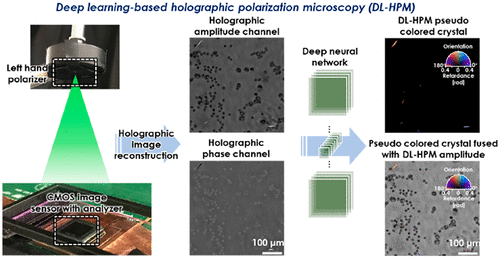当前位置:
X-MOL 学术
›
ACS Photonics
›
论文详情
Our official English website, www.x-mol.net, welcomes your
feedback! (Note: you will need to create a separate account there.)
Deep Learning-Based Holographic Polarization Microscopy
ACS Photonics ( IF 6.5 ) Pub Date : 2020-10-13 , DOI: 10.1021/acsphotonics.0c01051 Tairan Liu 1 , Kevin de Haan 1 , Bijie Bai 1 , Yair Rivenson 1 , Yi Luo 1 , Hongda Wang 1 , David Karalli 2 , Hongxiang Fu 3 , Yibo Zhang 1 , John FitzGerald 4 , Aydogan Ozcan 5
ACS Photonics ( IF 6.5 ) Pub Date : 2020-10-13 , DOI: 10.1021/acsphotonics.0c01051 Tairan Liu 1 , Kevin de Haan 1 , Bijie Bai 1 , Yair Rivenson 1 , Yi Luo 1 , Hongda Wang 1 , David Karalli 2 , Hongxiang Fu 3 , Yibo Zhang 1 , John FitzGerald 4 , Aydogan Ozcan 5
Affiliation

|
Polarized light microscopy provides high contrast to birefringent specimen and is widely used as a diagnostic tool in pathology. However, polarization microscopy systems typically operate by analyzing images collected from two or more light paths in different states of polarization, which lead to relatively complex optical designs, high system costs, or experienced technicians being required. Here, we present a deep learning-based holographic polarization microscope that is capable of obtaining quantitative birefringence retardance and orientation information of specimen from a phase-recovered hologram, while only requiring the addition of one polarizer/analyzer pair to an inline lensfree holographic imaging system. Using a deep neural network, the reconstructed holographic images from a single state of polarization can be transformed into images equivalent to those captured using a single-shot computational polarized light microscope (SCPLM). Our analysis shows that a trained deep neural network can extract the birefringence information using both the sample specific morphological features as well as the holographic amplitude and phase distribution. To demonstrate the efficacy of this method, we tested it by imaging various birefringent samples including, for example, monosodium urate and triamcinolone acetonide crystals. Our method achieves similar results to SCPLM both qualitatively and quantitatively, and due to its simpler optical design and significantly larger field-of-view this method has the potential to expand the access to polarization microscopy and its use for medical diagnosis in resource limited settings.
中文翻译:

基于深度学习的全息偏振显微镜
偏振光显微镜为双折射标本提供高对比度,被广泛用作病理学诊断工具。然而,偏振显微镜系统通常通过分析从处于不同偏振状态的两个或多个光路收集的图像来运行,这导致相对复杂的光学设计、高系统成本或需要有经验的技术人员。在这里,我们提出了一种基于深度学习的全息偏光显微镜,它能够从相位恢复全息图中获得样本的定量双折射延迟和取向信息,同时只需要向内嵌无透镜全息成像系统添加一个偏光器/分析器对. 使用深度神经网络,从单一偏振状态重建的全息图像可以转换为与使用单次计算偏振光显微镜 (SCPLM) 捕获的图像等效的图像。我们的分析表明,经过训练的深度神经网络可以使用样本特定的形态特征以及全息幅度和相位分布来提取双折射信息。为了证明该方法的功效,我们通过对各种双折射样品(包括例如尿酸钠和曲安奈德晶体)进行成像来对其进行测试。我们的方法在定性和定量上都达到了与 SCPLM 相似的结果,
更新日期:2020-11-18
中文翻译:

基于深度学习的全息偏振显微镜
偏振光显微镜为双折射标本提供高对比度,被广泛用作病理学诊断工具。然而,偏振显微镜系统通常通过分析从处于不同偏振状态的两个或多个光路收集的图像来运行,这导致相对复杂的光学设计、高系统成本或需要有经验的技术人员。在这里,我们提出了一种基于深度学习的全息偏光显微镜,它能够从相位恢复全息图中获得样本的定量双折射延迟和取向信息,同时只需要向内嵌无透镜全息成像系统添加一个偏光器/分析器对. 使用深度神经网络,从单一偏振状态重建的全息图像可以转换为与使用单次计算偏振光显微镜 (SCPLM) 捕获的图像等效的图像。我们的分析表明,经过训练的深度神经网络可以使用样本特定的形态特征以及全息幅度和相位分布来提取双折射信息。为了证明该方法的功效,我们通过对各种双折射样品(包括例如尿酸钠和曲安奈德晶体)进行成像来对其进行测试。我们的方法在定性和定量上都达到了与 SCPLM 相似的结果,











































 京公网安备 11010802027423号
京公网安备 11010802027423号